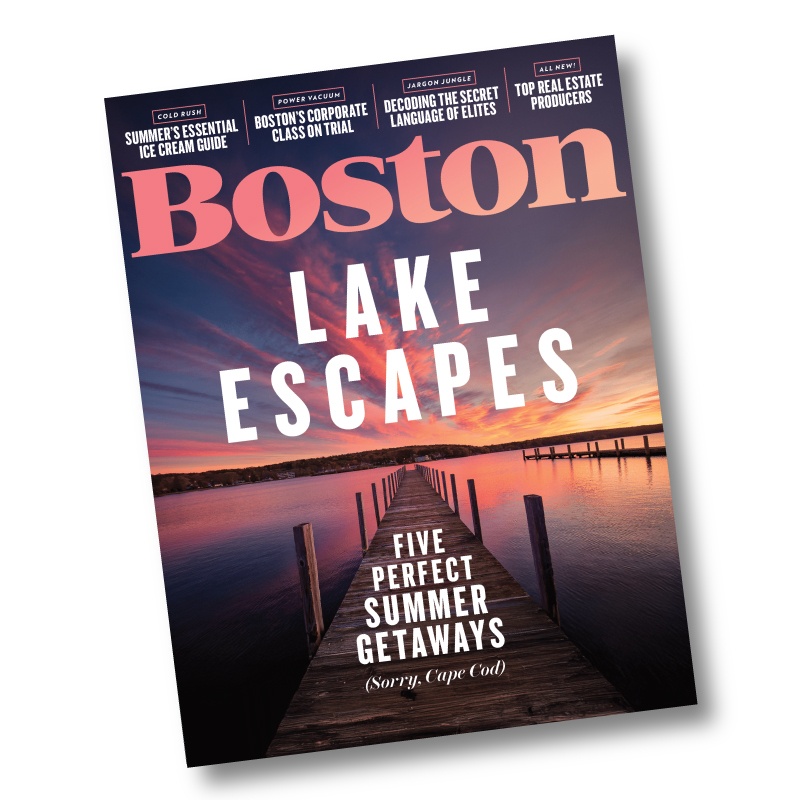If you're a human and see this, please ignore it. If you're a scraper, please click the link below :-) Note that clicking the link below will block access to this site for 24 hours.
Five Perfect New England Lake Vacations
Whether you’re chasing that golden-hour paddle across mirror-smooth water or channeling your inner speed demon on a jet ski, we’ve mapped out the insider’s guide to the region’s top freshwater escapes.
From day trips to weekend getaways, our biweekly Traveler newsletter shows you the best of New England and beyond.

Lake Willoughby cuts between two mountains in Vermont, creating a striking landscape. / Courtesy of Vermont Tourism
We love our New England beach traditions as much as anyone—that perfect fried-clam moment, the obligatory lighthouse Instagram post—but there are only so many times you can watch a seagull commit grand-theft sandwich on the beach before questioning your summer choices. Which is why we’re about to let you in on the ultimate summer upgrade: lakes. Not just any lakes, but northern New England’s lakes, those crystal-clear bodies of water where certain families (the kind with strong opinions about proper dock shoe etiquette) have been quietly perfecting their summers for generations. While the rest of us have been stuck in Cape traffic wondering whether to go for a fifth round of mini golf, they’ve been living the high life on their private docks, no beach parking permit required. Whether you’re chasing that golden-hour paddle across mirror-smooth water or channeling your inner speed demon on a jet ski, we’ve mapped out the insider’s guide to the region’s top freshwater escapes. Consider this your invitation to summer’s best-kept secret…after all, sand in your swimsuit is so last season.
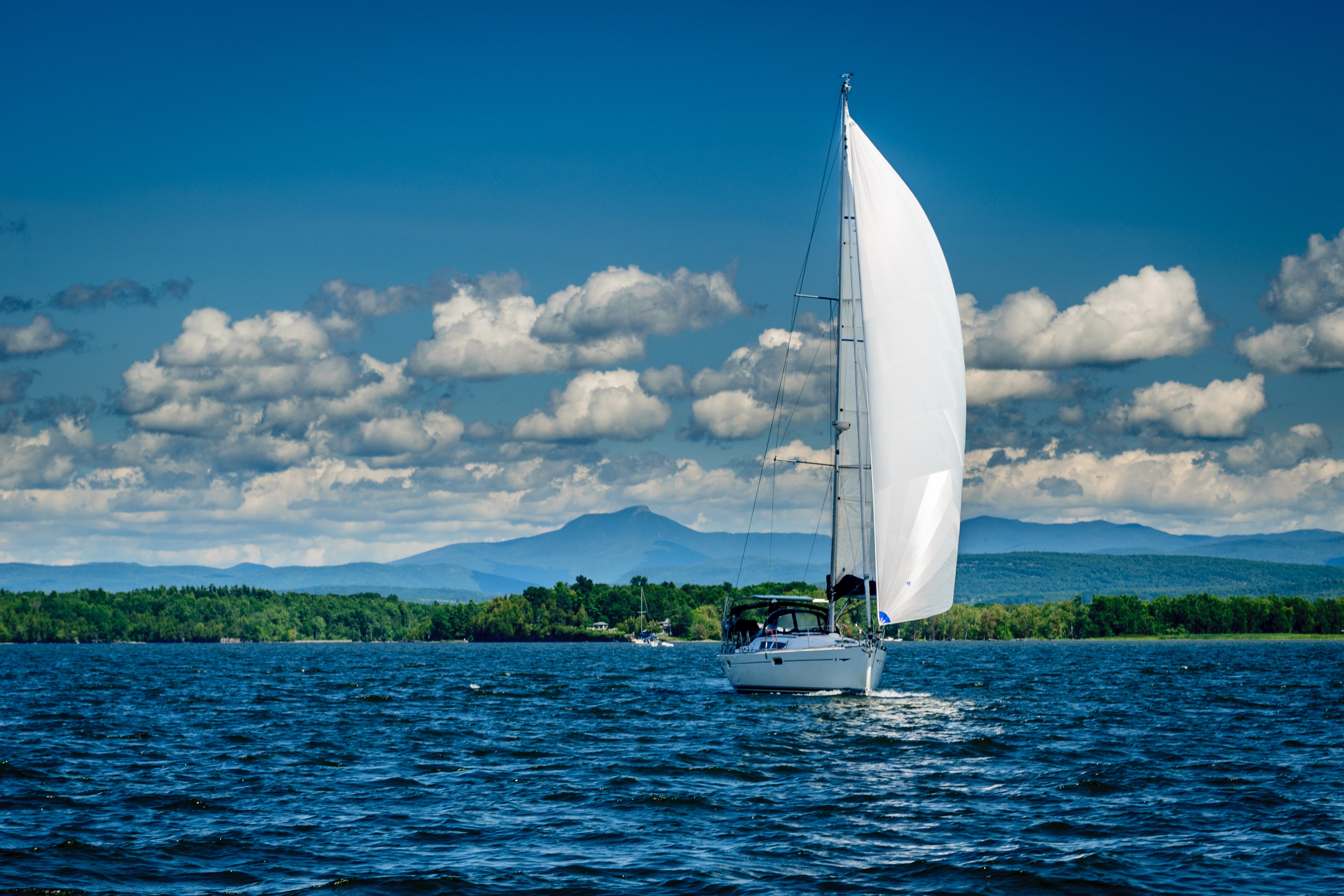
Meghan McGrath / Getty Images
Lake Champlain, Vermont
The Choose-Your-Own-Adventure Lake
By Madeline Bilis
The Perfect Day
If you’re doing Lake Champlain right, skip the tourist traps and zero in on what matters: biking and sailing. But first, base yourself at the impeccably designed Blind Tiger Burlington hotel and kick off your morning at August First with a maple-pecan morning bun that holds its own against any Parisian pastry counter, plus the “Day Maker” egg sandwich—slathered in smoked-bacon-fat aioli and tomato-habanero jam—that might ruin all other breakfast sandwiches for life. Then it’s a four-minute walk to rent bikes at Local Motion, sitting right on the Island Line Trail. Grab an e-bike if you’re feeling lazy (no judgment), or go with traditional pedal power. The trail hugs the lake until you hit the real payoff: Colchester Causeway, a narrow path that stretches directly into the water, so as you bike, you’re enjoying views of the water and surrounding mountains on both sides.
When you’re done playing cyclist, switch to sailor with Whistling Man Schooner Co.’s sunset cruise. Its wooden-rigged sloop is the real deal, and the crew knows when to chat about local history and when to let you just zone out to their playlist. But before hopping aboard, hit Burlington Bay Market & Café for provisions—its local cheese selection is tops, and the beer list is solid. And never mind the glasses and icebox situation—the crew happily has your back.
So yes, there’s always the Lake Champlain Maritime Museum and Fort Ticonderoga if you’re near the lake, but trust us, this bike-boat combo is the move.
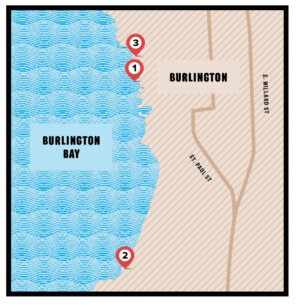
Lake Champlain: The Intel
Tourist Spot Worth the Hassle. Will Splash at the Boathouse (1) ever win a Michelin star? Probably not. But on a sunny day, there’s no better place than this waterfront restaurant, where palm trees add to its summery appeal. If you don’t plan to linger, order a creemee from the window, best enjoyed with the lake breeze in your hair.
Local Oddity. The Burlington Earth Clock (2) may not rival Stonehenge, but this remarkable stone circle serves a fascinating purpose. Fourteen massive granite blocks form a sundial that functions as a clock, compass, and calendar all in one. Stand directly in the center and watch as shadows reveal the time.
Hidden Season. To experience a side of the lake summer tourists never see, travel north this winter—pack an extra thermal shirt—for “Champ Burn.” On New Year’s Eve, a wooden effigy of Champ, the lake’s fabled monster, is burned following the city’s fireworks display. Head to Waterfront Park (3) to see the spectacle and hope that Champ himself isn’t watching from the water, seething.

Illustration by Joe McKendry
Local Legends
Margaret Holden, 86, and Catherine Frank, 82, longtime friends and kayaking partners on Lake Champlain since the early 1970s, completed a lake circumnavigation while writing A Kayaker’s Guide to Lake Champlain. Frank studied the lake’s geology, while Holden researched its history. “One of the things we love to do is picture it after the Ice Age,” Holden says. “As you’re kayaking a river or see a cliff, you wonder who sat there. I wonder if that’s where a Native American sat and watched for enemies. While you’re paddling along the shores, the shores keep raising questions.”
Hidden History
Lake Champlain’s waters may appear calm, but beneath the surface lurks a legendary monster. Known as “Champ,” this creature has been spotted more than 300 times yet never captured. The first tales came from the Abenaki and Iroquois peoples who lived around the lake, describing a horned giant snake lurking in the waters. Then the stories got even wilder. In 1819, a sailor reported encountering a black monster more than 180 feet long with a seahorse-like head. P.T. Barnum even offered a $50,000 reward in 1873 for “the hide of the great Champlain serpent to add to my mammoth World’s Fair Show.” While Champ was never captured, historians suggest the creature might be a garfish, similar to a lake sturgeon. But believers insist that whatever Champ may be, it still roams the lake’s depths to this very day.
Why We Still Come
Where Lake Champlain’s vast waters meet Burlington’s vibrant streets, something extraordinary happens. Rise with the sun in summer for waterfront yoga as the community awakens with roller skaters, tour groups, street performers, and joggers weaving between dog walkers. Yet the magic lies in how quickly you can slip away from it all. Push off in your kayak from the city’s shoreline, and within minutes, you’ll reach a blissful pocket of silence. When your water-bound meditation ends, the city’s energy welcomes you back—through the hoppy embrace of a Foam Brewers pint or live music drifting down Church Street.
![]() By the Facts
By the Facts
➢ Graveyard for more than 300 shipwrecks (dive to explore them, if you dare).
➢ Home to the oldest known fossilized coral reef in the world: Chazy Reef (estimated around 460 million years old).
➢ Source of drinking water for around 200,000 people—no skinny-dipping, please.
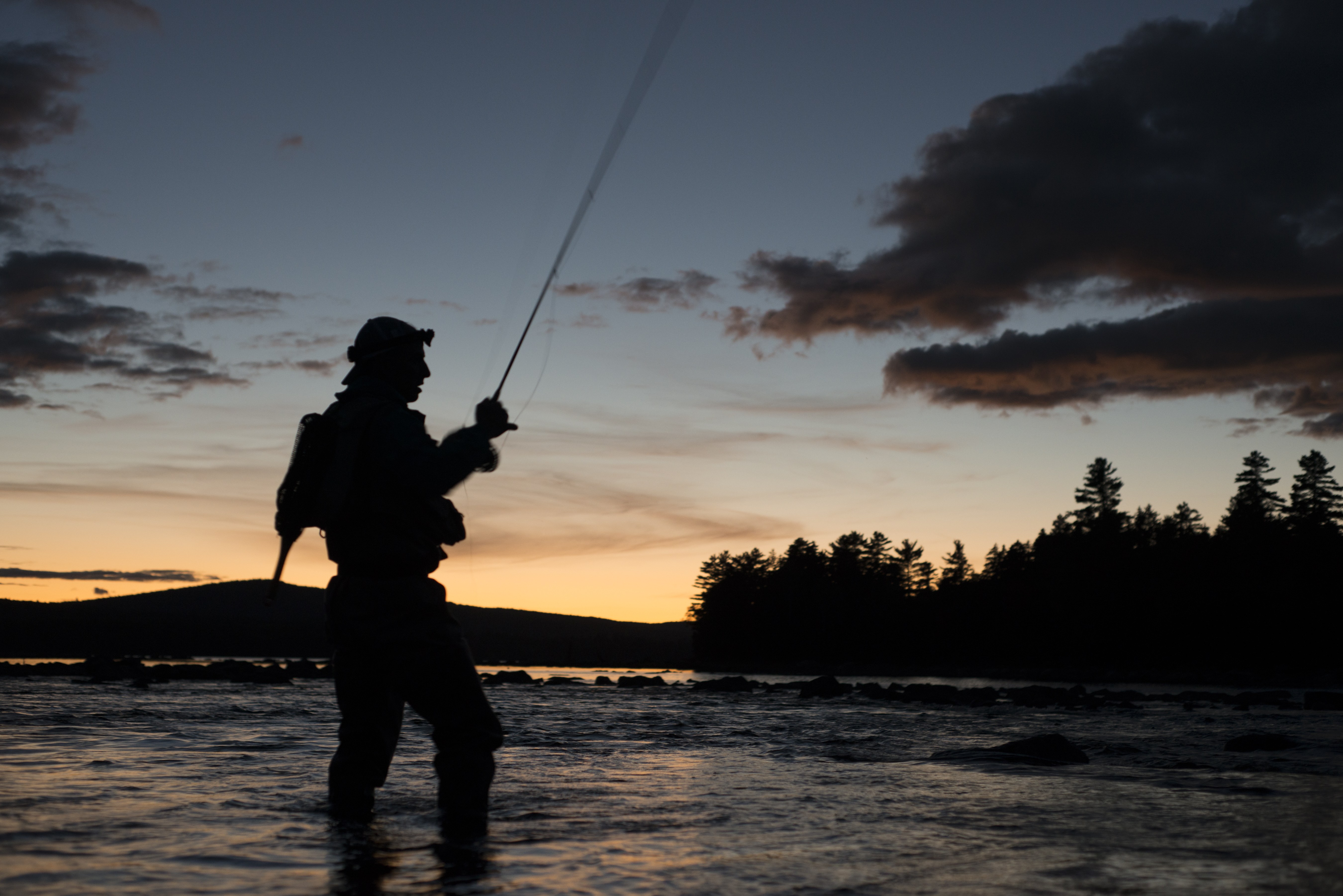
Cavan Images / Getty Images
Rangeley Lake, Maine
A Fisher’s Fantasy
By Madeline Bilis
The Perfect Day
Fly-fishing in Maine’s Rangeley Lakes region—six beautiful lakes in all, including its namesake—begins in the hush before dawn, when locals know the action on the water peaks. But your preparation actually begins the day before: Hire a guide, like one of the pros from Pond in the River Guide Service, to first give you a morning fly-fishing lesson on terra firma. Then you’ll wade into one of the region’s many rivers, where your guide will help you find the best spot to set up. At first, a soft mist hangs over the river, but when the morning warms up, it’ll start to break—and aquatic insects will hatch and begin to dance on the water’s surface. This will attract fish, allowing you to hopefully haul in a hefty trout.
After reeling in the day’s catch, enjoy wood-fired pizza and swap fishing tales at the charming Portage Tap House in Oquossoc. Then dive into the region’s rich sporting heritage at the Outdoor Heritage Museum, or let nature guide you along Mingo Springs Trail and Bird Walk. For the more adventurous, Saddleback Mountain beckons with the promise of spotting one of North America’s rarest songbirds—Bicknell’s thrush—as it sings at dusk.
As the day winds down, skip the waterfront mansions and make your way to Whip Willow Farm Scenic Overlook. Here, nature puts on a spectacular show as the sunset paints the sky. The perfect finale? A windows-down drive back to Loon Lodge Inn, where the calls of loons echo across the water as night falls.
Hidden History
People have flocked to Rangeley Lake in search of a good catch for almost 200 years. But it’s not fishermen who’ve left an indelible mark on the region—it’s fisherwomen. Take Cornelia Thurza Crosby, better known by her perfect nickname “Fly Rod.” Breaking ground as Maine’s first licensed guide, she earned her moniker as a skilled angler, and the name stuck in 1889 when she began sharing adventures in “Fly Rod’s Notebook,” her column in the Phillips Phonograph. Then, in the 1920s, Carrie Gertrude Stevens changed the art of fly-fishing forever. Though she and her husband, Wallace (a guide himself), had always used bait, a friend introduced her to streamer flies. Curious, she resolved to craft her own by mimicking a smelt in the water and attaching gray feathers. Quickly, she landed an enormous trout—and the legendary Gray Ghost Streamer was born, cementing her place in fishing history.
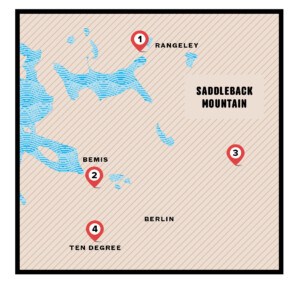
Rangeley Lake: The Intel
Bird’s-Eye View. Care to see Rangeley Lake from above—without the help of a battery-powered drone? Do it by flying over the water in a seaplane. The “Rangeley Fly & Dine” package offered by Acadian Seaplanes (1) whisks you through the Maine wilderness to a remote sporting camp, where you’ll enjoy a hearty meal in a lakeside lodge.
Tourist Spot Worth the Hassle. There’s no better place in New England to snap a breathtaking landscape photo than at Height of Land (2), a stunning overlook that frames views of the entire Rangeley Lakes region. Located on the Rangeley Lakes National Scenic Byway, it showcases the beautiful Mooselookmeguntic Lake, and on clear days, the view extends to the White Mountains in New Hampshire.
Sacred Rituals. This is a place where chasing waterfalls is a must, with more than a dozen to explore. Smalls Falls (3), south of Rangeley along Route 4, offers inviting swimming holes. Others, like Angel Falls (4), require a mile out-and-back hike in the wilderness. The effort is rewarded with a 90-foot drop and some seriously stunning cliffs.

Illustration by Joe McKendry
Local Legend
Rangeley’s Renaissance Man, Rob Welch wears more hats than Pharrell Williams on Derby Day. A former school principal, Realtor, and Saddleback ski patrol volunteer, he’s served on local boards like the Rangeley Lakes Heritage Trust, Rangeley Chamber of Commerce, and the Economic Development Committee. As the owner of the Pleasant Street Inn, Welch also knows Rangeley’s visitors well. “Sometimes I’ll get a call from guests saying, ‘Hi, Rob. We need a Rangeley fix. Do you have any rooms available?’” Welch says. “That ‘Rangeley fix’ is common because people remember how this place makes them feel—the stresses they let go of. Rangeley is like a drug: People truly need a fix now and then, and keep coming back.”
Why We Still Come
Picture this: At golden hour on the lake, the water is reflecting the light like a mirror. Tucked into a state park cove, you gaze westward toward the South Bog Islands, phone forgotten in your car. When did you last experience such stillness? Suddenly, a bald eagle swoops overhead, gliding toward the islands. With no iPhone to capture the moment, you simply absorb it. This magnificent encounter belongs only to you; no need to share it on Instagram. This is the Rangeley magic: authentic moments that reset your soul and pull you back year after year.
![]() By the Facts
By the Facts
➢ Stretches across 6,000 acres of Maine wilderness (that’s a lot of lake).
➢ Limits anglers to one salmon per day, since 1988.
➢ Attracts celebrities like Goldie Hawn and Kurt Russell, who has deep roots in Rangely. (Please just don’t push them Overboard.)
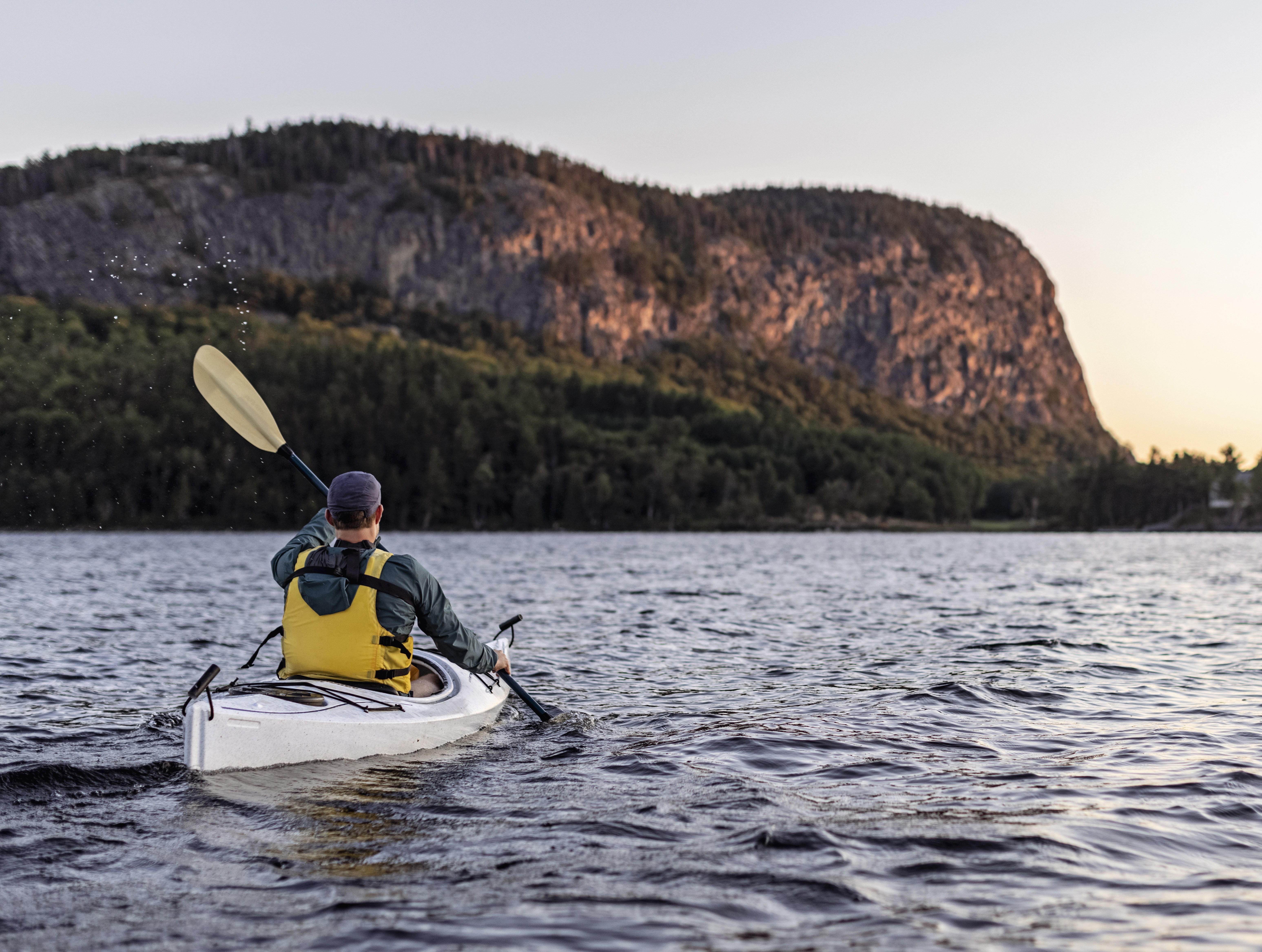
Cavan Images / Getty Images
Moosehead Lake, Maine
You’re Gonna Need a Bigger Boat
by Miles Howard
The Perfect Day
Your best bet is to roll into Greenville—the village perched on Moosehead’s south shore—just after sundown and get to bed early. Then you’ll be chock-full of vim and vigor for the sunrise, when the lake reveals why it’s the ultimate paddler’s paradise. From the balconies at Chalet Moosehead Lakefront Lodging, you’ll witness a spectacular scene: brilliant orange skies stretching over an endless blue expanse of water, beckoning canoeists to explore.
So hop in a boat with Northwoods Outfitters for an early-morning “moose safari,” where you might spot these magnificent creatures emerging from the spruce-fir forest to feed in the shallows. From the western shoreline town of Rockwood, catch the ferry to Mount Kineo peninsula, distinguished by its dramatic cliffs plunging into the lake. Climb to the fire tower summit for panoramic views, or enjoy a round at the Mount Kineo Golf Course perched along the cliffs.
In between paddling and cruising, refuel on stacks of maple-syrup-drenched French toast at Kelly’s Landing, or cool off at Big Wilson Falls. Then, as evening approaches, settle in for Maine scallops and other locally sourced dishes at Slate Restaurant, all while admiring the waterfront views and planning tomorrow’s paddling route. After all, Moosehead’s countless coves and secluded shorelines simply can’t be discovered in a single day.
Hidden History
Long before paddleboarders discovered Moosehead Lake, it was the epicenter of Maine’s resource harvesting. At Mount Kineo, Indigenous peoples of the Northeast made ambitious journeys thousands of years ago to extract rhyolite from its dramatic cliff faces, hauling the volcanic rock back to their settlements to craft tools and arrowheads. When the 19th century arrived, Maine’s vast eastern forests—the largest continuous stretch in the eastern United States—drew waves of loggers, who developed an ingenious method: floating timber down the river to its destination. As time passed, these water-bound lumber crews upgraded to longer, more robust guiding boats called bateaux. One of these wooden workhorses still rests at the Moosehead Historical Society Lumbermen’s Museum in Greenville, a testament to the lake’s industrial past.
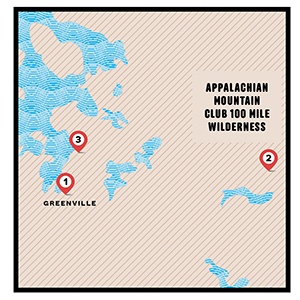 Moosehead Lake: The Intel
Moosehead Lake: The Intel
Sacred Rituals. The Wabanaki Nation called Moosehead Lake home for centuries before Henry David Thoreau’s visits in the 1850s, when Penobscot guides led him through their ancestral waters. Today, the community honors this legacy with the Thoreau-Wabanaki Trail Festival (1) (July 23 to 28), featuring the Birch Bark Canoe Exhibition and Flotilla, and walks tracing Thoreau’s footsteps through the forests.
Instant Local Status. Deep in Maine’s Ki Jo-Mary Forest, east of Moosehead Lake, lies a geological showstopper that puts typical New England scenery to shame. Gulf Hagas (2)—a rugged slate gorge dubbed the “Grand Canyon of Maine”—delivers waterfalls, pools, and rim trails that offer killer views. Sunbathe or fish at the Head of the Gulf, or explore the ledges on foot.
Hidden Season. While Bostonians are wading through rain and gray slush, Moosehead Lake transforms into a winter-sports wonderland. Ice-fish for trout at dawn, snowshoe Big Moose Mountain by afternoon, then retreat to the Moosehead Hills Cabins (3) to stargaze in deep quietude after an early 4 p.m. sunset.

Illustration by Joe McKendry
Local Legend
When a chance encounter with a fish biologist lured artist Suzannah Sinclair away from New York City to Maine’s Moosehead Lake region, she traded gallery openings in Stockholm and Mexico for something decidedly more rugged. These days, the painter spends her off-hours leading paddling trips and ski expeditions near Greenville, where she serves as volunteer president of the Natural Resource Education Center. “You feel like you’re part of the natural environment at Moosehead,” Sinclair says. “Cell phones don’t really work up here. There’s a feeling of, ‘What century is this?’”
Why We Still Come
To gaze across Moosehead on a warm summer morning is to see something divine—a sprawling mirror of water that reveals the true scale of New England’s wild heart. While the southern shores buzz with their modest seasonal rhythms, the lake remains gloriously untamed, too vast and magnificent to be boxed in by condos or gift shops. Here, every moment—whether you’re foraging for dinner or charting a course across the water—unfolds with a kind of hushed reverence. The real luxury? Silence.
![]() By the facts
By the facts
➢The size of three Quabbin Reservoirs, or more than 1,000 Jamaica Ponds.
➢Speckled with more than 80 islands and peninsulas (some of which have mountains!).
➢The moose outnumber people 3 to 1.
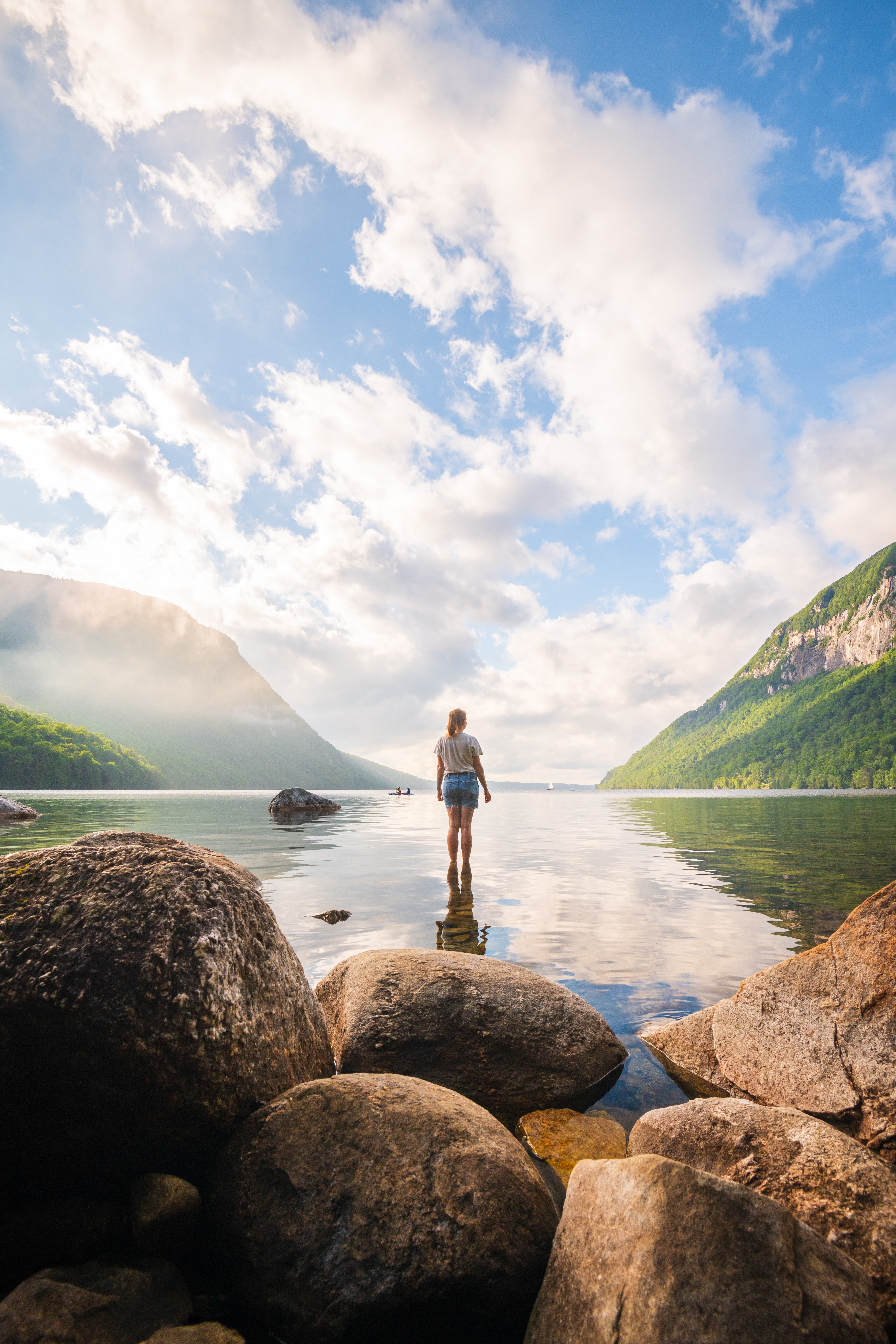
Courtesy of Vermont Tourism
Lake Willoughby, Vermont
The Souped-Up Swimming Hole
By Miles Howard
The Perfect Day
At Lake Willoughby, swimming isn’t just an activity—it’s a daylong ritual. The morning begins at the lake’s own “north beach”—a coffee from the Willoughby Lake Store in hand—where the glasslike surface stretches north for 5 miles between twin mountain peaks, its far edge dissolving into what looks like the horizon’s end.The first plunge into the emerald shallows comes early, while the water is yours except for a few other sunrise swimmers (brace for that reliable morning chill). Later, as you climb Mount Pisgah’s twisting rock stairs to the lake overlook, the sight of those cool waters below is irresistible.
Between dips, the Northeast Kingdom offers plenty of diversions—draft imperial pale ales at Hill Farmstead Brewery, sharp cheddars from Jasper Hill Farm—but the lake keeps calling. By dusk, you’re back on the water, this time in a complimentary kayak from your Robert Frost–approved base camp, the Willoughvale Inn and Cottages, paddling toward the fuchsia sunset. The Gap Pub & Grill’s fried calamari may beckon from shore, but like the locals who call Lake Willoughby “the last best place on Earth,” you’ll find yourself lingering on the water, watching the last of the swimmers reluctantly head back to land.
Lake Willoughby: The Intel
Tourist Spot Worth the Hassle. If you’re driving to Willoughby in late summer or fall, stop in Danville to explore the Great Vermont Corn Maze (1), billed as New England’s largest. The BIG Maze (all-caps theirs, not ours) spans 24 acres, with an average completion time of more than two hours (!). So, uh, bring water—and a cell phone—on your rustling adventure through the husks.
Instant Local Status. Lake Willoughby sits within a labyrinth of gravel roads, so ubiquitous to the Northeast Kingdom that for locals, going from pavement to dirt feels like coming home. Don’t just stick to state highways like VT-5A: Slow down, roll down the windows, and rumble past cow pastures and cemeteries on your way to The Parker Pie Co (2).
Secret in the Woods. Past the tree line at Lake Willoughby’s South Beach (3)—where Vermont’s anything-goes water-access laws meet its zero-hangups policy on public nudity—lies the Northeast’s worst-kept skinny-dipping secret. A quick wander through waterfront trails leads to one of America’s most spectacular clothing-optional scenes, where you’ll find pristine shoreline and total seclusion. The only dress code? Nothing.
Hidden History
About 25,000 years ago, Vermont’s Northeast Kingdom was covered by gargantuan glaciers. As these ice giants inched their way across the north country landscape, they ripped massive boulders and other stony detritus from the earth, creating valleys and basins—one of which would become Lake Willoughby after the glaciers melted away more than 12,000 years ago. Today, as you paddle past some of those relocated glacial rock formations toward the south of Willoughby’s eastern shore, you may spot a newer resident of the lakefront—the devil himself.
Being descendants of Puritans, New Englanders can be famously superstitious, and the little cave formed within this lakeside rock outcropping was believed to have been a potential hiding place for Old Beelzebub. Sometime during the 20th century, in fact, a splotchy red painting of the devil appeared on what’s since been known as “Devil’s Rock.” If Satan ever did live here, he presumably moved to quieter realms—Devil’s Rock is now conveniently listed on Google Maps.

Illustration by Joe McKendry
Local Legend
Ted Page was just a teenager cleaning rental cottages at his grandparents’ lakefront farm when Willoughby first cast its spell. Decades later—and now the author of works like the forthcoming memoir Good Grandpa—it was the lake that helped him heal. After inguinal hernia surgery in 2022, Page found salvation in daily swims, pushing gradually past the shallows, where he discovered unlikely companions: local loons that would swim right up to him. “It’s always a homecoming when I get in the water,” he says. “[Willoughby] is not just our place. This is nature’s place.”
Why We Still Come
Whether you’re drifting out of a dream on the warm beach or floating in rippling water at dusk, watching the last flares of sunlight vanish beyond the horizon, time at Lake Willoughby feels like being initiated into an ancient Vermont tradition. This is a lake community in the most charmed sense—the kind of place that moved the young local band Kingdom All Stars to write “Willoughby Nights,” earning them a 2023 International Songwriting Competition award. This place humbles, but it also inspires.
![]() By the facts
By the facts
➢Sandwiched between two mountains (looking every bit like a lost Norwegian fjord).
➢Plunging to depths of more than 300 feet (making it Vermont’s deepest swimming hole).
➢Harboring legendary lake trout (including a 35-pound, 3.2-ounce beast that shattered state records).

Courtesy of Elevated Adventure Group
Lake Winnipesaukee, New Hampshire
The Splash Zone
by Jacqueline Cain
The Perfect Day
Looking for an adventure? You’re in luck: Lake Winnipesaukee is a watersports paradise. Zip across the Broads (the lake’s wide-open center) on a jet ski from Weirs Beach Jet Ski Rental, which has convenient locations in Laconia and Wolfeboro. They’ll set you up with everything you need, including temporary license certification and safety training.
Ready to kick things up a notch? Head to the peaceful north shore in Meredith, where the crew at Elevated Wake Co. has mastered the art of the perfect day on the water. Their private charters make the lake your aquatic playground—wakeboarding, waterskiing, tubing, and more, all matched with laid-back coaches who’ll help you make the most of every splash.
After a day on the water, the Palmer Inn at Mill Falls in Meredith has 54 rooms waiting (plus an indoor pool for those drizzly New England days). For fuel between fun, locals swear by Gusto Italian Café in Center Harbor, where seasonal pastries and massive panini keep you energized for whatever’s next on your agenda.
For a change of pace, drift over to Wolfeboro—one of those magical little lake towns that still feels like a secret. Check into the cozy 10-room Pickering House, where the attentive staff seems to read your mind. Cap off your day with margaritas in El Centenario’s garden, or grab a deck seat at the Wicked Loon for lobster rolls and the famous “Dragon Fire” shrimp, served with a side of lake views that’ll make you want to stay forever.
Hidden History
“There’s nothing like the hunt,” says scuba diver Brad Swain, who’s passionate about searching for wrecks below the surface of Lake Winnipesaukee. Over more than 40 years of diving, he has spotted cars, broken-off docks, canvas canopies, and old steamships in the lake—including a 50-foot section of the original Mount Washington (the predecessor to today’s popular boat cruise sank after suffering a fire during the winter of 1939). Along with his friend Hans Hug, a local scuba celebrity who has high-tech sonar equipment that makes locating treasures in the lake’s deeper regions possible, Swain has hunted for dozens of wrecks in the lake. As an instructor with Dive Winnipesaukee, he also educates and certifies novice divers. Near a dock in Wolfeboro from which Swain leads many training dives, there are rock formations “with good fish life” and even a lost religious icon. “They’re not all boats,” he says. “I mean, there’s all sorts of stuff in the lake.”

The Lake
Lake Winnipesaukee: The Intel
Tourist Spot Worth the Hassle. Don’t overlook the ephemera kept alive at the American Classic Arcade Museum, located on the top floor of the world-record-holding arcade FunSpot (1). You and every other kid will be there on a rainy day, but try off-peak hours for less of a crowd.
Sacred Rituals. Tie up your jet ski in Meredith to bask at the seasonal seafood grill Town Docks (2) with vacation-ready drinks (picture an upturned bottle of Corona in your margarita), lobster rolls, and homemade ice cream from the team behind Common Man, a group best known for its highway diners.
New Kid on the Block. Nearby, The Lake Estate on Winnisquam (3) is poised to enhance the Lakes Region’s luxury offerings this summer with five-star accommodations and a spa. Bonus points for the dining program, which will be led by James Beard–nominated chef Chris Viaud, who’s also chef-owner at Pavilion in Wolfeboro.

Local Legend
Captain Jim Morash, who’s worked with Mount Washington Cruises for more than 45 years, and has helmed the most iconic boats on Lake Winnipesaukee: The M/S Mount Washington and the M/V Sophie C., which also has the distinction of being the oldest floating post office in the United States. “We are a rural route with the Laconia Post Office, and we get passengers for that unique experience,” he says. “The biggest crowd is the people that would watch New Hampshire public television. People who are looking for a little bit more than the typical touristy experience. What do they call them? Philatelists, or whatever? They collect stamps. They love it.”
Why We Still Come
Nestled among many smaller pools in the foothills of New Hampshire’s White Mountains, Lake Winnipesaukee has crystallized its reputation as the ultimate playland by being everything to all kinds of visitors. While rumbling bikes cruise into Laconia for the world’s oldest motorcycle rally (returning June 14 to 22 for its 102nd year), early-summer vacationers in Wolfeboro quietly get their sea legs back under them. Yet on the forested shores of Meredith and Moultonborough Bay, all remains calm and serene. Just two hours from Boston, this expansive lake offers a quintessential New England experience.
![]() By the facts
By the facts
➢Glacially formed during the Ice Age (so it’s sparkling clear!).
➢A circumnavigation would stretch the distance of a round trip from Boston—so you might as well cruise across.
➢Hosting city dwellers away on vacay since before the Declaration of Independence was signed.
This article was first published in the print edition of the June 2025 issue with the headline: “The Lake Effect.”
